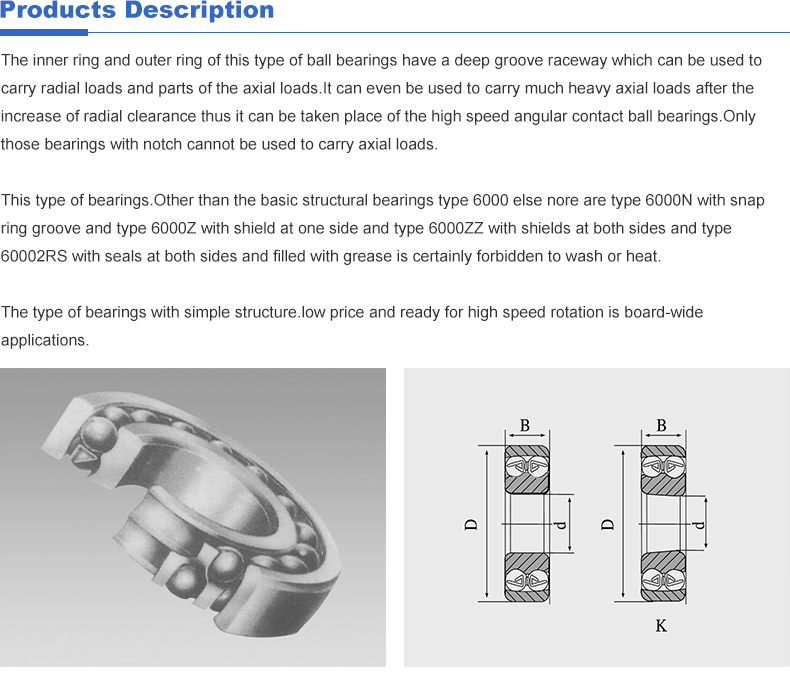
Aug . 01, 2024 00:11 Back to list
Understanding the Benefits and Applications of Cylindrical Roller and Ball Bearings in Machinery
Understanding Cylindrical Roller Bearings An In-Depth Look
Cylindrical roller bearings are a critical component in many mechanical applications, offering several advantages in terms of load capacity, operating speed, and durability. Designed to handle radial loads, these bearings feature cylindrical rollers, which are positioned between two races – an inner race and an outer race. The design of these rollers allows them to maintain a high degree of contact with the raceways, leading to efficient load distribution and enhanced performance.
Structure and Design
The unique structure of cylindrical roller bearings sets them apart from other bearing types, such as ball bearings. The cylindrical shape of the rollers enables them to roll smoothly and reduces the amount of friction generated during operation. This characteristic is particularly advantageous in applications where high speeds and heavy loads are present. Standard cylindrical roller bearings come in various configurations, including single-row, double-row, and multi-row designs, allowing engineers to select the ideal bearing for specific applications.
Single-row cylindrical roller bearings are often used in situations where space is limited and a high load capacity is required. They can accommodate radial loads and some axial loads in one direction, making them suitable for vertical and horizontal shaft applications. On the other hand, double-row cylindrical roller bearings are designed to support higher radial loads and are ideal for applications that require increased load-carrying capacity, such as in heavy machinery and industrial equipment.
Advantages of Cylindrical Roller Bearings
One of the primary advantages of cylindrical roller bearings is their ability to sustain heavy loads. The larger contact area between the rollers and the races allows these bearings to distribute loads more evenly, which helps to reduce wear and extend service life. Moreover, their design enables them to handle misalignment better than other bearing types, making them a reliable choice in situations where there may be shaft deflection or other alignment issues.
cylindrical roller ball bearing

Another key benefit is their capacity for high-speed operation. The reduced friction and heat generation in cylindrical roller bearings allow for smoother performance in high-speed applications. This characteristic is essential in industries such as automotive and aerospace, where precision and efficiency are critical.
Additionally, cylindrical roller bearings generally require less maintenance than other bearing types, contributing to lower operational costs over time. They are typically sealed or shielded to prevent contamination from dirt and moisture, which can lead to premature failure. This design makes them suitable for use in harsh environments, including those found in manufacturing plants and mining operations.
Applications Across Industries
Cylindrical roller bearings are utilized in various industries, including automotive, manufacturing, heavy machinery, and robotics. In the automotive sector, these bearings are often found in gearboxes, wheel hubs, and transmission systems, where they help reduce friction and improve overall efficiency. In manufacturing, cylindrical roller bearings are essential components in conveyor systems, pumps, and turbines.
Moreover, the versatility of cylindrical roller bearings means they can be tailored for specific applications through custom designs and materials. Engineers can select from a range of materials, including steel, stainless steel, and ceramic, depending on the operational environment and performance requirements.
Conclusion
Cylindrical roller bearings are a vital component in modern engineering and manufacturing, providing excellent load-carrying capacity, reduced friction, and low maintenance needs. Their unique design and adaptability make them suitable for a wide range of applications, ensuring their continued relevance in advancing technology. As industries evolve and demands increase, cylindrical roller bearings will remain a cornerstone of reliable machinery and equipment. Understanding their characteristics and applications is essential for anyone involved in engineering, manufacturing, or maintenance, as they play a crucial role in optimizing performance and enhancing efficiency.
Latest news
-
Common Failures in Thrust Ball Bearings and Solutions
NewsAug.22,2025
-
How Tapered Roller Bearings Can Take Shock Loads
NewsAug.22,2025
-
Angular Bearings in High-Precision Spindles
NewsAug.22,2025
-
The Impact of Misalignment on Cylindrical Roller Bearing Performance
NewsAug.22,2025
-
The Role of Cage Design in Deep Groove Ball Bearing Durability
NewsAug.22,2025
-
The Impact of Material Quality on Machinery Bearings’ Lifespan
NewsAug.22,2025
